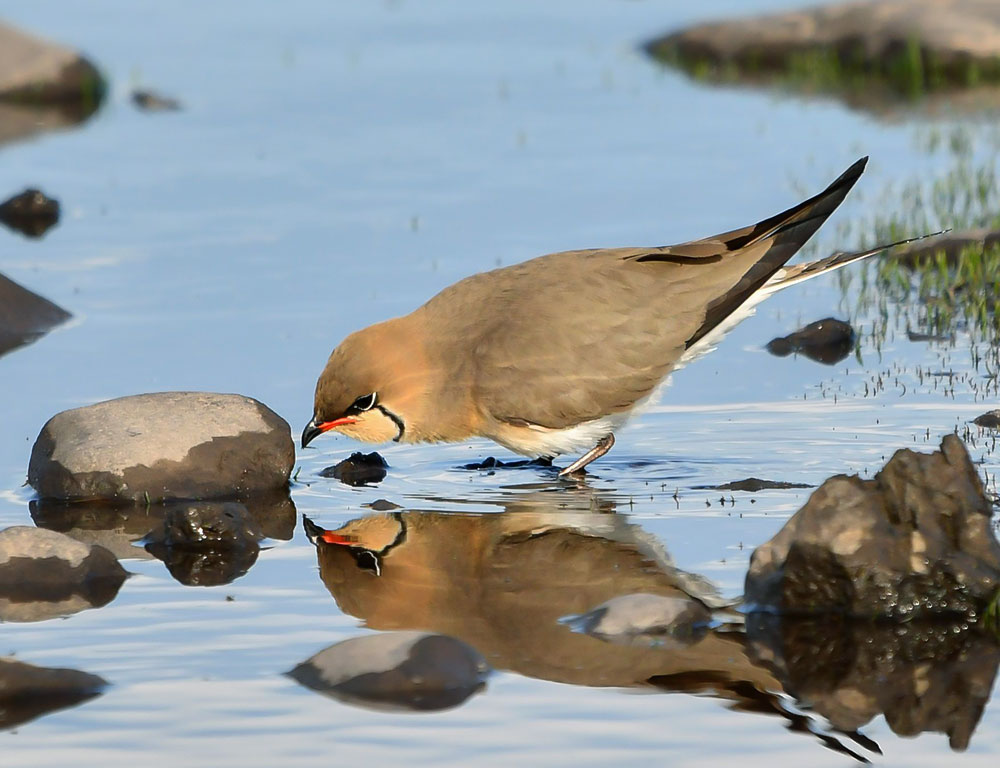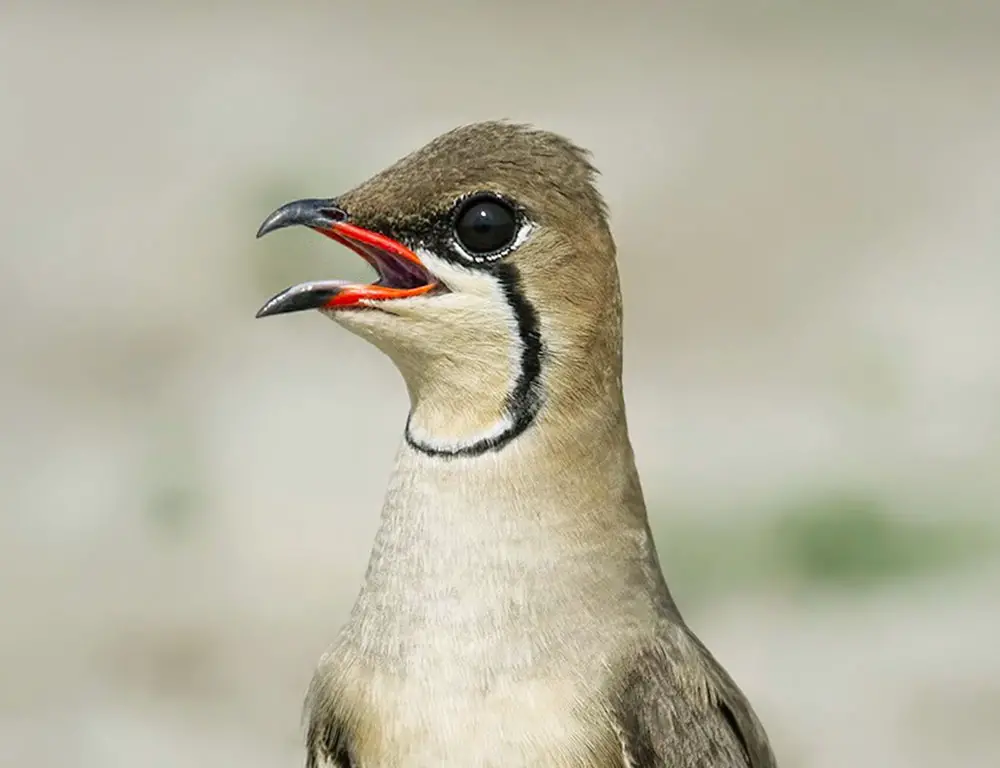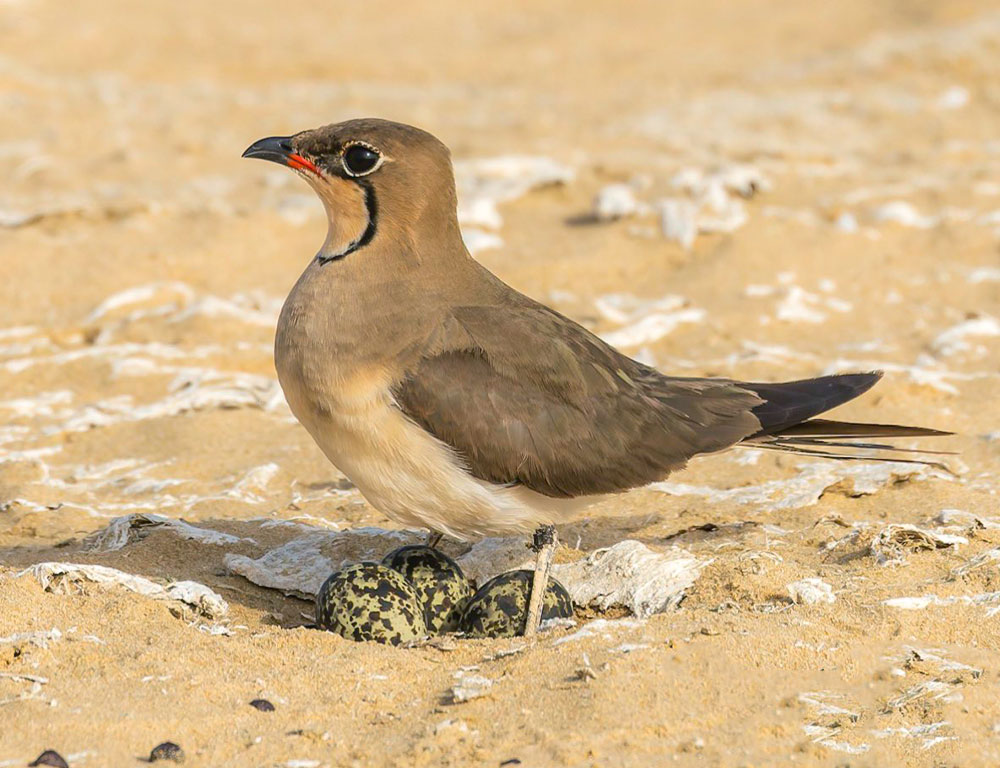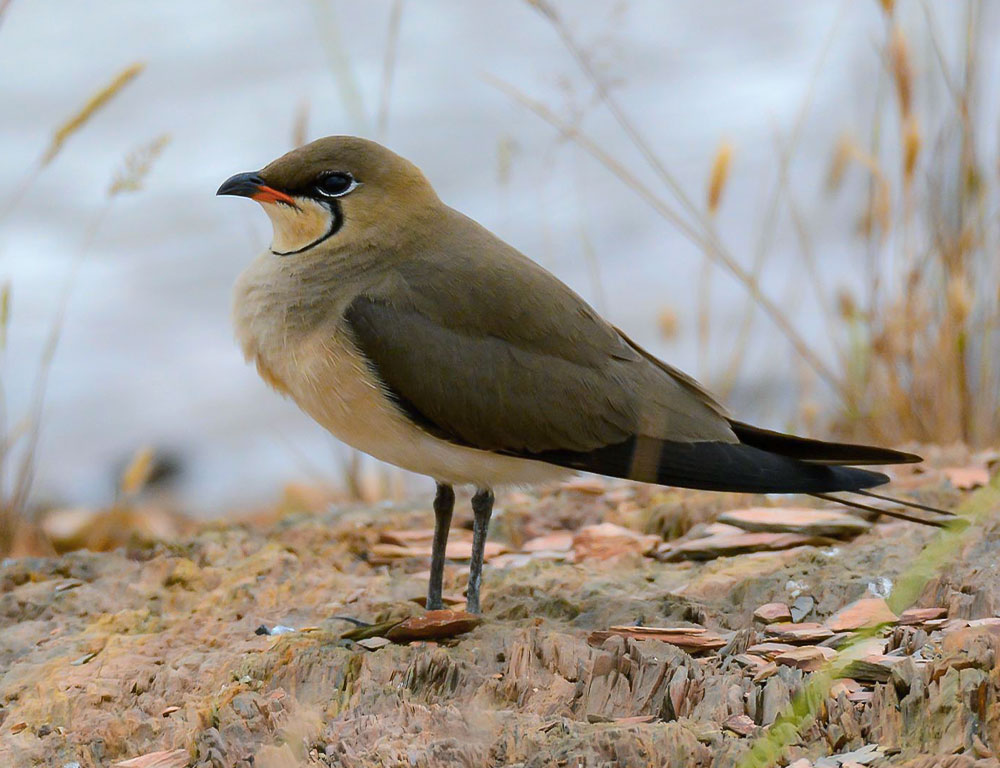The Collared Pratincole (Glareola pratincola) is a captivating bird species that often flies under the radar despite its remarkable features and behaviors.
Found across Africa, Asia, and parts of Europe during migration seasons, this bird’s elegant appearance and dynamic flight make it a sight to behold.
The Collared Pratincole stands out in its habitat with a wingspan of up to 60 cm, distinct grey-brown plumage, and a striking white collar encircling its neck. Its adeptness at catching insects mid-air while in flight adds to its allure.
Nesting on open ground and exhibiting communal breeding behavior, this species offers insights into the intricate dynamics of avian life.
Through further exploration, the Collared Pratincole reveals itself as a fascinating subject deserving our attention and appreciation.

Physical Characteristics of Collared Pratincole
The Collared Pratincole (Glareola pratincola) is a fascinating bird species known for its unique physical characteristics that make it stand out in its habitat.
Here’s an overview of its notable physical traits:
Size
Collared Pratincoles are medium-sized birds, typically measuring between 24 to 28 centimeters (9.4 to 11 inches) in length from beak to tail. While not large birds, they have a sleek and slender appearance and are well-adapted for their aerial lifestyle.
Wingspan
One of the most remarkable features of the Collared Pratincole is its long wingspan, which can measure up to 60 centimeters (approximately 24 inches).
These elongated wings enable the bird to execute agile and swift flight maneuvers, essential for capturing prey and navigating its environment.
Plumage
The Collared Pratincole’s plumage is predominantly grey-brown on the upper parts, providing effective camouflage in its grassland and wetland habitats.
The bird’s coloration helps it blend seamlessly into its surroundings, making it less visible to predators and prey alike. The underparts are typically lighter in color, further aiding in camouflage.
Neck Collar
One of the most distinctive features of the Collared Pratincole is the thin white collar that outlines its neck, giving the bird its common name. This collar stands out against the bird’s grey-brown plumage.
Beak
Collared Pratincoles have a short, straight beak well-suited for their insectivorous diet. The beak is black with a reddish base. This specialized beak allows the bird to catch flying insects precisely while in flight, demonstrating its remarkable hunting abilities.
Legs
The legs of the Collared Pratincole are relatively short but intense, and they are adapted for walking on the ground and perching on low vegetation. These sturdy legs enable the bird to move swiftly across various terrain, including grasslands, wetlands, and agricultural fields.
Eyes

Like most birds, the Collared Pratincole has large, dark eyes on either side of its head. Its keen eyesight is essential for detecting prey, avoiding obstacles during flight, and monitoring its surroundings for potential threats.
Habitat and Distribution of Collared Pratincole
The Collared Pratincole (Glareola pratincola) is a bird species known for its wide distribution across various continents.
Here’s an overview of its habitat and distribution:
Habitat
- Grasslands: Collared Pratincoles are commonly found in open grasslands, meadows, and plains. These habitats provide suitable foraging grounds where the birds can hunt for insects, their primary food source.
- Wetlands: They are often associated with wetland areas such as marshes, riverbanks, and lakeshores. These habitats offer opportunities for foraging, nesting, and roosting and access to water for drinking and bathing.
- Agricultural Fields: In some regions, Collared Pratincoles may also inhabit agricultural areas with open fields and pastures. However, they typically avoid heavily cultivated or urbanized areas and prefer natural or semi-natural landscapes.
- Coastal Areas: During migration, Collared Pratincoles may be observed along coastal regions, especially during stopovers or while crossing bodies of water. However, they are not strictly coastal birds and primarily inhabit inland habitats.
Distribution
- Africa: Collared Pratincoles breed across various parts of Africa, including the Sahel region, the Mediterranean coast, and sub-Saharan Africa. They can be found in countries such as Senegal, Mali, Niger, Chad, Sudan, Ethiopia, Kenya, Tanzania, and Zambia, among others.
- Europe: Breeding populations of Collared Pratincoles are present in select regions of southern Europe, including Spain, Portugal, Italy, Greece, and Bulgaria. They may also occur as vagrants or migrants in other European countries during migration seasons.
- Asia: Collared Pratincoles breed in parts of Asia, particularly in the Middle East, Central Asia, and South Asia. They occur in Turkey, Iraq, Iran, Azerbaijan, Kazakhstan, Uzbekistan, Turkmenistan, Afghanistan, Pakistan, India, and Sri Lanka.
Behavior of Collared Pratincole
The behavior of the Collared Pratincole (Glareola pratincola) is fascinating and reflects its environmental adaptation.
Here are some critical aspects of their behavior:
Social Behavior
Collared Pratincoles are social birds, especially during the breeding season. They often form large colonies or groups, nesting close together in suitable habitats such as grasslands near water bodies.
This social behavior provides benefits such as collective defense against predators and increased opportunities for finding mates.
Feeding Behavior
As primarily insectivorous birds, Collared Pratincoles display agile and skilled feeding behavior. They are adept at catching flying insects mid-air, utilizing their swift flight and maneuverability to snatch prey such as beetles, grasshoppers, and ants.
They may also feed opportunistically on insects found on the ground, especially during twilight hours when insects are most active.
Nesting Behavior

During the breeding season, Collared Pratincoles exhibit meticulous nesting behavior. They may lay their eggs directly on the ground, often in shallow scrapes or depressions.
Nest sites are typically located in open areas with sparse vegetation, providing good visibility and protection from predators.
Both male and female Collared Pratincoles incubate the eggs and care for the young chicks after hatching.
Territoriality
While Collared Pratincoles are social birds and may nest in colonies, they can also display territorial behavior, particularly around their nest sites. They may engage in displays or vocalizations to defend their territory from intruders or potential threats.
Flight Behavior
Collared Pratincoles are known for their swift and agile flight. Their long, pointed wings enable them to glide effortlessly over open habitats such as grasslands and wetlands. Graceful glides and occasional rapid wingbeats characterize their flight.
They may take flight to escape when threatened, but they are also capable runners, often darting swiftly on foot to evade predators.
Migration Behavior
Like many migratory birds, Collared Pratincoles undertake long-distance migrations between their breeding and wintering grounds. Their migration behavior is characterized by seasonal movements between Europe, Africa, and parts of Asia.
They follow established migratory routes, often traveling in flocks during migration.
Conservation Status

The conservation status of the Collared Pratincole (Glareola pratincola) is currently assessed as “Least Concern” by the International Union for Conservation of Nature (IUCN).
However, while this designation indicates that the species is not currently facing imminent threats of extinction, it does not imply that the Collared Pratincole is free from conservation concerns.
Here are some key points regarding its conservation status:
Population Trends
Overall, the global population of Collared Pratincoles appears stable, and the species is widely distributed across its range in Africa, Asia, and parts of Europe.
However, localized populations and subpopulations may be experiencing declines due to specific threats.
Threats
Despite being classified as Least Concern, Collared Pratincoles face various threats to their populations in different parts of their range.
These threats include habitat loss and degradation, particularly the conversion of natural grassland habitats for agriculture and urban development.
Wetland drainage and alteration also pose threats to their breeding and foraging habitats.
Climate Change
Climate change is another emerging threat that could impact Collared Pratincoles and their habitats.
Changes in precipitation patterns, temperature regimes, and habitat availability could affect the availability of suitable breeding and foraging areas and disrupt migratory patterns and timing.
Conservation Efforts
Conservation efforts to protect Collared Pratincoles and their habitats are underway in various regions. These efforts include habitat conservation and restoration initiatives, designated protected areas, and monitoring populations and migration patterns.
Conservation organizations, government agencies, and local communities are collaborating to implement conservation measures for the species.
Research and Monitoring
Continued research and monitoring efforts are essential for understanding Collared Pratincoles’ population dynamics, ecology, and conservation needs.
Long-term studies on breeding success, migration patterns, and habitat use can provide valuable insights into the factors affecting the species and inform conservation strategies.
FAQs
What is the lifespan of a Collared Pratincole?
The lifespan of a Collared Pratincole in the wild is typically around 5 to 7 years, although some individuals may live longer in favorable conditions.
When do Collared Pratincoles breed?
In European regions, the breeding season for Collared Pratincoles typically falls between May and July, coinciding with their arrival back on European soil after wintering in Africa.
How do Collared Pratincoles communicate?
Collared Pratincoles communicate through various vocalizations, including calls and alarm signals, to alert others of danger or to communicate within their colony.
What predators do Collared Pratincoles face?
Common predators of Collared Pratincoles include birds of prey such as hawks and falcons and mammals like foxes and feral cats that may prey on eggs or young chicks.
How do Collared Pratincoles protect their nests?
Collared Pratincoles defend their nests through collective defense behaviors within their colonies. They may mob potential threats or issue alarm calls to warn neighboring individuals of danger.
To Recap
The Collared Pratincole emerges as a captivating and enigmatic bird species deserving of admiration and conservation efforts.
From its distinctive physical characteristics, such as its elegant plumage and aerodynamic form, to its fascinating behaviors, including communal breeding and agile aerial hunting, this bird offers a glimpse into the intricate world of avian life.
Despite facing threats of habitat loss and degradation, the Collared Pratincole persists across its range, demonstrating resilience and adaptability.
As stewards of the natural world, we are responsible for safeguarding the habitats and ecosystems upon which this species depends.
By appreciating and protecting the Collared Pratincole and its environment, we preserve biodiversity and ensure a brighter future for this remarkable bird and its ecosystems.